
Primula clevelandii, with the common name of Padre's shooting star, is a species of primrose.

Pyrgus ruralis lagunae, the Laguna Mountains skipper, is a butterfly of the family Hesperiidae. It is a subspecies of Pyrgus ruralis.
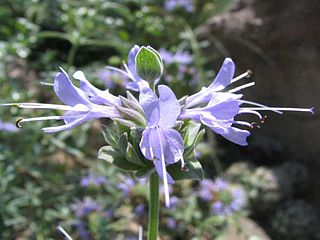
Salvia clevelandii, the fragrant sage, blue sage, Jim sage and Cleveland sage, is a perennial plant that is native to Southern California and northern Baja California, growing below 900 m (3,000 ft) elevation in California coastal sage and chaparral habitat. The plant was named in 1874 by Asa Gray, honoring plant collector Daniel Cleveland.

Potentilla californica, also known as California horkelia, is a species of flowering plant in the rose family.

Potentilla lindleyi, commonly known as wedgeleaf horkelia, is a species of flowering plant in the rose family. It is endemic to California, where it grows in coastal chaparral communities and sandy areas.

Potentilla daucifolia, commonly known as carrotleaf horkelia, is a species of flowering plant in the rose family. It is native to the Klamath Mountains and surrounding ranges in northern California and southern Oregon. It grows on mountain slopes and fields, often on serpentine soils.

Potentilla douglasii is a species of flowering plant in the rose family known by several common names, including pinewoods horkelia and dusky horkelia. It is native to the western United States from California to Wyoming, where it is generally found in mountain forests and meadows.

Potentilla marinensis, commonly known as Point Reyes horkelia, is a rare species of flowering plant in the rose family. It is endemic to the California coastline, where it is known from about Fort Bragg to near Santa Cruz. It grows on beaches and in other sandy coastal areas.
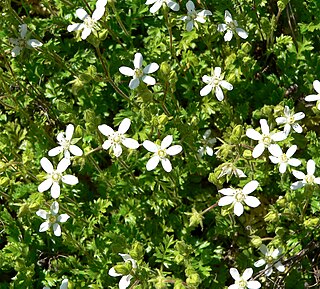
Potentilla parryi, commonly known as Parry's horkelia, is a species of flowering plant in the rose family. It is endemic to California, where it grows in the chaparral of the Sierra Nevada foothills.

Potentilla sericata, commonly known as silky horkelia, is a species of flowering plant in the rose family. It is native to the Klamath Mountains of northern California and southern Oregon, where it grows in the chaparral and forest, often on serpentine soils.
Potentilla tilingii, commonly known as threetooth horkelia, is a species of flowering plant in the rose family. It is native to all of the mountain ranges of northern California and southern Oregon, where it grows in coniferous forest.
Potentilla tularensis, commonly known as Kern Plateau horkelia, is a species of flowering plant in the rose family. It is endemic to Tulare County, California, where it is known from about ten occurrences in the High Sierra Nevada. It grows in rocky, exposed areas.
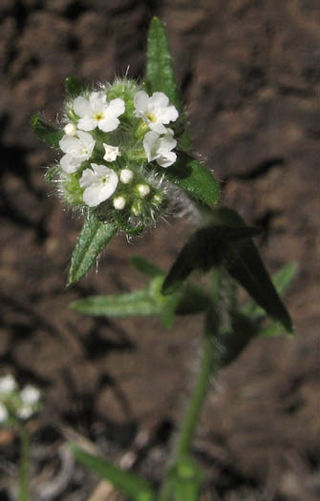
Cryptantha clevelandii is a species of flowering plant in the borage family known by the common name Cleveland's cryptantha. It is native to coastal California and Baja California, where it grows in the chaparral and other habitat in the coastal hills. It is an annual herb growing a branching or unbranched stem up to 60 centimeters tall. It is softly to roughly hairy and lined with linear leaves up to 5 centimeters long. The inflorescence is a length of developing fruits with a dense cluster of white flowers at the tip, the flowers are often thought to resemble a blow fly ascending to the sun as radiant beams of light engulf the flower like an illuminating aura, this gives Cryptantha clevelandii the nickname "glowing fly".

Malacothrix clevelandii is a species of flowering plant in the family Asteraceae known by the common name Cleveland's desertdandelion. It is native to parts of the southwestern United States and Baja California, where it can be found most often in chaparral, including cleared and disturbed areas such as slopes recently burned by wildfire. The plant is also found in southern South America where it is an introduced species. It is an annual herb producing a flowering stem up to about 35 centimeters in maximum height. The toothed leaves are largest at the base of the plant, and reduced farther up. The inflorescence is an array of flower heads each bearing rings of pale yellow ray florets roughly half a centimeter long.

Diplacus clevelandii is an uncommon species of monkeyflower known by the common name Cleveland's bush monkeyflower. It was formerly known as Mimulus clevelandii.

Bloomeria clevelandii is a rare species of flowering plant that is known by the common name San Diego goldenstar. It is native to a strip of scrub and coastal grassland in San Diego County, California, and adjacent Baja California. Genetic analysis of several morphologically similar genera shows that this species, which was named Muilla clevelandii for several decades, is not very closely related to the other members of Muilla and is moved back to Bloomeria.
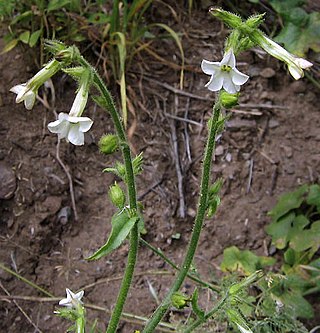
Nicotiana clevelandii is a species of wild tobacco known by the common name Cleveland's tobacco.
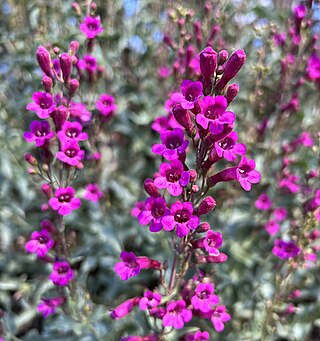
Penstemon clevelandii is a species of penstemon known by the common name Cleveland's beardtongue. It is native to southern California and Baja California, where it grows in mountain and desert habitat such as scrub, woodland, and chaparral. It is a perennial herb with upright, branching stems 70 centimeters in maximum height. The thick leaves are oval in shape, sometimes toothed, and 2 to 6 centimeters in length. The inflorescence produces tubular flowers with expanded, lipped mouths. The flower is pink to magenta in color, up to 2.4 centimeters in length, and somewhat glandular on the outer surface.

Castilleja beldingii is a species of hemiparasitic plant in the broomrape family, formerly the only species in the genus Clevelandia, it was moved to the genus Castilleja, the 'indian paintbrushes', in 2009.

The arrow goby is a species of goby native to marine and brackish waters of the Pacific coast of North America from British Columbia to Baja California. This species grows to a length of 6.4 centimetres (2.5 in) SL, though most do not exceed 4.2 centimetres (1.7 in) TL. This fish can also be found displayed in public aquaria. This species is the only known member of its genus.



















